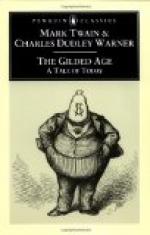The jury finally threw themselves back upon the indisputable fact that Selby was dead, that either wound would have killed him (admitted by the doctors), and rendered a verdict that he died from pistol-shot wounds inflicted by a pistol in the hands of Laura Hawkins.
The morning papers blazed with big type, and overflowed with details of the murder. The accounts in the evening papers were only the premonitory drops to this mighty shower. The scene was dramatically worked up in column after column. There were sketches, biographical and historical. There were long “specials” from Washington, giving a full history of Laura’s career there, with the names of men with whom she was said to be intimate, a description of Senator Dilworthy’s residence and of his family, and of Laura’s room in his house, and a sketch of the Senator’s appearance and what he said. There was a great deal about her beauty, her accomplishments and her brilliant position in society, and her doubtful position in society. There was also an interview with Col. Sellers and another with Washington Hawkins, the brother of the murderess. One journal had a long dispatch from Hawkeye, reporting the excitement in that quiet village and the reception of the awful intelligence.
All the parties had been “interviewed.” There were reports of conversations with the clerk at the hotel; with the call-boy; with the waiter at table with all the witnesses, with the policeman, with the landlord (who wanted it understood that nothing of that sort had ever happened in his house before, although it had always been frequented by the best Southern society,) and with Mrs. Col. Selby. There were diagrams illustrating the scene of the shooting, and views of the hotel and street, and portraits of the parties. There were three minute and different statements from the doctors about the wounds, so technically worded that nobody could understand them. Harry and Laura had also been “interviewed” and there was a statement from Philip himself, which a reporter had knocked him up out of bed at midnight to give, though how he found him, Philip never could conjecture.
What some of the journals lacked in suitable length for the occasion, they made up in encyclopaedic information about other similar murders and shootings.
The statement from Laura was not full, in fact it was fragmentary, and consisted of nine parts of, the reporter’s valuable observations to one of Laura’s, and it was, as the reporter significantly remarked, “incoherent”, but it appeared that Laura claimed to be Selby’s wife, or to have been his wife, that he had deserted her and betrayed her, and that she was going to follow him to Europe. When the reporter asked:
“What made you shoot him Miss. Hawkins?”
Laura’s only reply was, very simply,
“Did I shoot him? Do they say I shot him?”. And she would say no more.
The news of the murder was made the excitement of the day. Talk of it filled the town. The facts reported were scrutinized, the standing of the parties was discussed, the dozen different theories of the motive, broached in the newspapers, were disputed over.




